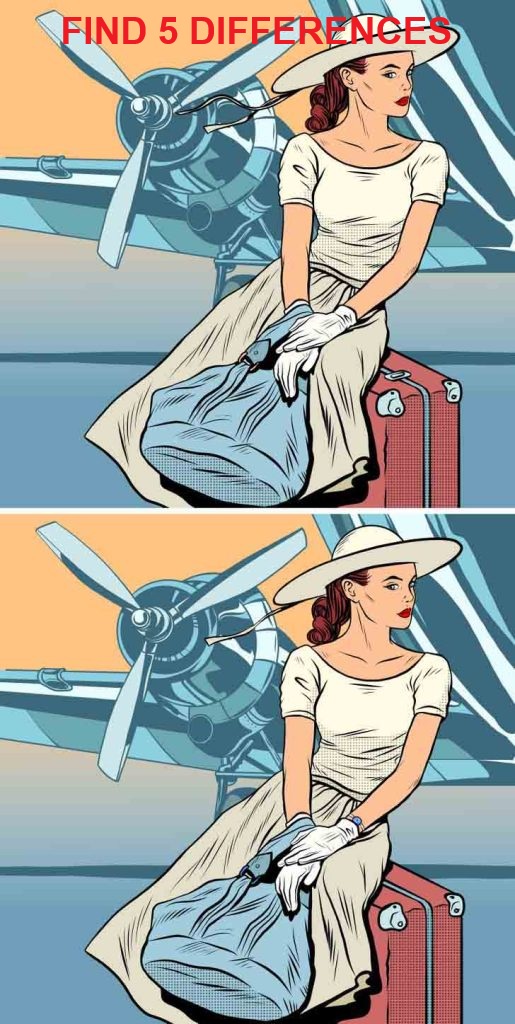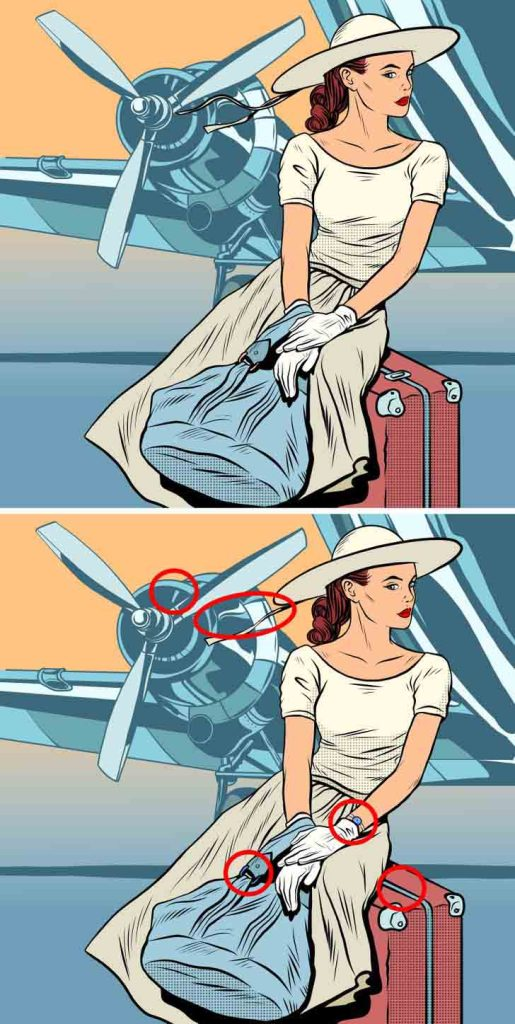Warm-Up Challenge: Can You Spot Them All?
Here’s a classic “spot-the-difference” puzzle to wake up your brain. Two illustrations look almost identical: a stylish traveler in a wide-brim hat sits on a suitcase by a propeller plane. But five tiny tweaks hide in plain sight. Before you read further, take 60 seconds and scan both images. Which details jump out first—colors, shapes, or missing objects? And be honest: how many do you see before the timer in your head runs out?

Why These Puzzles Fool Even Sharp Eyes
Spot-the-difference isn’t just “look and point.” Your visual system loves patterns and often “fills in” what it expects to see. That’s how artists trick you with micro-changes. Most people fall into three traps:
- Staring without strategy. We sweep our eyes randomly. Without a route, you re-check the same areas and miss obvious changes elsewhere.
- Ignoring edges and hardware. Our brains prioritize faces and fabric, not hinges, vents, fasteners, or seams—exactly where puzzle makers love to hide differences.
- Letting symmetry trick you. When two objects mirror each other (propeller blades, glove folds, suitcase corners), small asymmetries slip by because the overall shape still “feels” right.
The fix? Use a deliberate scan and compare shapes, not “objects.” Think: circles vs. ovals, straight vs. curved, present vs. missing, open vs. closed.
How to Solve This One Step by Step
Below is a guided route that mirrors how professional spotters (design reviewers, QA artists, even airframe inspectors) check visuals—top-left to bottom-right, with intentional stops at “hardware points.”
Video : Find 5 Differences between two pictures | Spot the Differences | Riddle Hunt
Step 1: Sweep the Propeller Assembly (Top Left)
Start with the aircraft’s nose and propeller where lots of repeating geometry appears. Look at each blade’s root (where it meets the hub) and the small metal cap at the center. See anything subtle? In one image, a detail near a propeller blade is altered: a small shape/line at the blade root doesn’t match the other picture. Because your mind expects perfect symmetry around the hub, it autocorrects—so slow down and trace each blade junction with your eyes.
Step 2: Scan the Fuselage Lines and Openings (Mid Background)
Follow the fuselage and the cowling. You’ll notice a tiny opening that looks like a slot or grill—an air vent (duct/air intake)—that changes between images. Vents are textbook hiding spots: they’re small, linear, and blend into the aircraft’s blue-gray tones. If you missed it on your first pass, you’re not alone.
Step 3: Check the Traveler’s Accessories (Center)
Shift to the woman’s hands and wrists. Jewelry is another classic ambush. In one image she wears a bracelet; in the other, it’s missing or altered. Don’t just count items—confirm their outline and thickness. A thin bangle can visually disappear next to white gloves and skin tones if you’re scanning too fast.
Step 4: Inspect Bags, Buckles, and Closures (Lower Center-Left)
Next, evaluate the soft bag resting against her dress. Hardware on soft goods—the bag’s clasp/lock—often flips from closed to open, from ring to tab, or from present to absent. Because the fabric folds suggest movement, your brain attributes small hardware changes to lighting or wrinkles. Force yourself to outline the clasp: its silhouette should match in both images. It doesn’t.
Step 5: Finish at the Suitcase Corners (Lower Right)
Round off your path with the luggage she’s sitting on. Corners, feet, and metal latches are tiny but high-contrast. Here, the suitcase lock/latch differs. The hue and shadow trick your perception, but compare the shape and placement rather than “color.” Once you switch to shape-based comparison, the mismatch is obvious.

Why This Route Works (and How to Use It Anywhere)
Notice the order we used: from high-symmetry mechanics (propeller) → linear features (fuselage/vent) → human focus (hands/wrist) → soft-goods hardware (bag clasp) → corner hardware (suitcase lock). This “macro-to-micro with hardware checkpoints” method reduces re-scanning and catches the exact kinds of edits artists like to hide.
You can reuse this on any picture puzzle:
- Frame the zones. Split the image mentally into a 3×3 grid and clear each cell before moving on.
- Prioritize hardware. Scan joints, hinges, vents, latches, zippers, buckles, seams, and stitching.
- Trace edges. Run your eyes along outlines (hat brim, propeller blades, suitcase corners). Edge breaks betray changes faster than interior colors.
- Flip focus. After a global scan, zoom into contrast “lowlands” (muted blues/greys) where edits hide best.
- Confirm with opposites. Ask: present vs. missing? convex vs. concave? round vs. angular? closed vs. open?
Common Mistakes You Can Dodge Next Time
- Color fixation. You hunt for hue shifts and miss structural differences. Solution: compare geometry first.
- Speed-scanning. You chase a “got it!” rush and lock in the first few differences, then stop looking. Solution: commit to clearing every grid cell.
- Central bias. You live in the middle of the picture and ignore borders. Solution: lap the perimeter clockwise, then counter-clockwise.
Video : Spot 5 Differences | Find 5 Differences between two pictures | Riddle Hunt
Your Official Answer Key (With Micro-Explanations)
Here’s the full list of five differences in this puzzle, matching the route above:
- Near the propeller blade: A small detail around the blade root/hub differs between images—an altered line/shape that breaks symmetry.
- Air vent/duct on the aircraft: A slim opening along the fuselage/cowling changes (added/removed/reshaped).
- Bag clasp/lock: The fastener on the soft bag is different—its presence or form doesn’t match.
- Bracelet: The wrist accessory appears in one image and not the other (or changes style/position).
- Suitcase lock/latch: The metal latch on the luggage corner is altered.
If you got all five without peeking—nicely done. If you found three or four, you’re close; implement the hardware-first scan next time and you’ll nail the full set.
Level Up: Sharpen Your Visual Intelligence
Want to get faster? Try this training loop:
- 30-second preview: Give yourself a strict half-minute to map zones and “predict” likely edit spots (hardware, edges, repeated shapes).
- Two-pass method: Pass 1 for geometry, Pass 2 for textures (shadows, stitching, tiny vents).
- Reverse the order: Solve once top-left → bottom-right. Then repeat bottom-right → top-left. Reversing exposes blind spots.
- Describe out loud: Verbalizing shapes (“oval latch,” “three-toed clasp ring,” “thin vent slit”) locks details into memory.

Your Turn—Join the Hunt
How many did you catch before reading the guide? Which one gave you the most trouble—the propeller symmetry or that sneaky suitcase latch? Drop your count, your toughest spot, and your personal strategy in the comments. If you used a unique method (color-only scan, reflection checks, or alternating eye focus), share it—someone else will learn from your approach.
And if this puzzle fired up your neurons, don’t stop here. Challenge yourself with more “Find the Difference” sets, hidden-object scenes, and visual odd-one-out games. The more you practice, the sharper your pattern recognition, edge detection, and spatial reasoning become—skills that translate to everything from proofreading and UX audits to photography and even driving.
Ready for round two? Save this post, share it with a friend, and time each other. The next puzzle is waiting—and so is your new personal best.